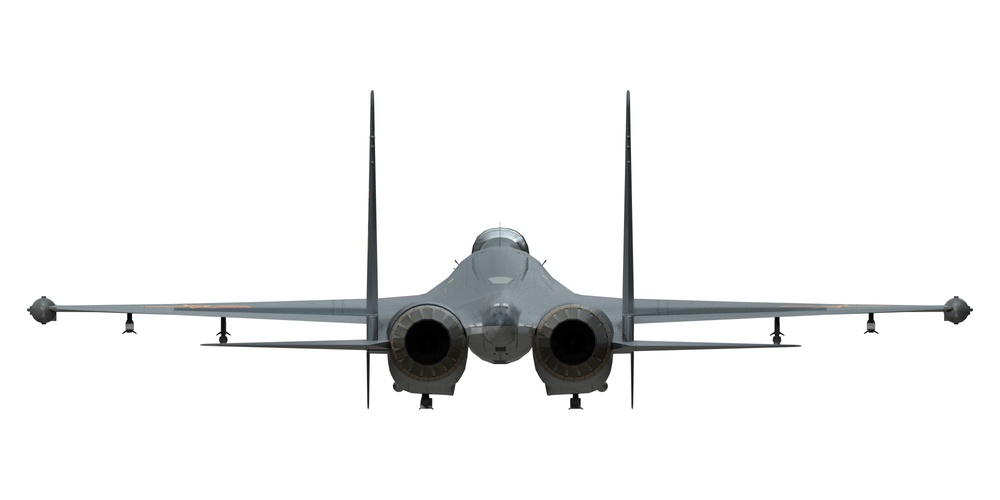
Shenyang J-11 Back Orthographic View
Due to the limitations of GFE and Software Center, I utilized my personal equipment and models to create this 4K render of the Orthographic View.
All requests for 3D modeling, rendering, animation, or simulations should be directed to NAWDC Media.
The Shenyang J-11 (NATO reporting name: Flanker-B+/L) is a Chinese twin-engine, multirole fighter aircraft manufactured by the Shenyang Aircraft Corporation (SAC). It is a license-produced and extensively upgraded derivative of the Soviet-designed Sukhoi Su-27SK air superiority fighter, forming a cornerstone of the People's Liberation Army Air Force (PLAAF).
Here are its key specifications, noting that there are significant variations between the initial J-11 and later, indigenously upgraded J-11B/BG/D variants:
General Characteristics (primarily J-11B variant):
Crew: 1 (J-11B); 2 (J-11BS - two-seat version)
Length: 21.9 m (71 ft 10 in)
Wingspan: 14.7 m (48 ft 3 in)
Height: 5.92 m (19 ft 5 in)
Wing Area: 62.0 m² (667 sq ft)
Empty Weight: Approximately 16,380 kg (36,112 lb)
Gross Weight: 23,926 kg (52,748 lb)
Max Takeoff Weight (MTOW): 33,000 kg (72,753 lb) (J-11B); reportedly up to 32,000 kg (70,548 lb) for J-11BG
Fuel Capacity: 9,400 kg (20,723 lb) internal
Powerplant:
Early J-11/J-11A: 2 × Lyulka (now Saturn) AL-31F afterburning turbofan engines (approx. 123 kN / 27,500 lbf with afterburner each)
Later J-11B and variants: 2 × Shenyang WS-10A "Taihang" afterburning turbofan engines (approx. 132 kN / 29,700 lbf with afterburner each); WS-10B with 13.2 tons thrust for J-11BG
Performance:
Maximum Speed: Mach 2.35 (approximately 2,500 km/h or 1,553 mph) at altitude
Range: 3,530 km (2,190 mi, 1,910 nmi)
Combat Range: Approximately 1,500 km (930 mi, 810 nmi)
Service Ceiling: 19,000 m (62,000 ft)
Rate of Climb: 300 m/s (59,000 ft/min)
G-Limits: +9g
Armament:
Gun: 1 × 30mm Gryazev-Shipunov GSh-30-1 cannon with 150 rounds
Hardpoints: 10 (J-11B, J-11BS) to 12 (J-11D, J-11BG) external hardpoints with a maximum capacity of 6,500 kg (14,330 lb) for J-11B; up to 8,000 kg (17,637 lb) for J-11BG.
Missiles (J-11B/BG/D can carry a wider range of indigenous missiles):
Air-to-Air: PL-8 (short-range IR), PL-9 (short-range IR), PL-10 (short-range IR, later variants), PL-12 (medium-range active radar homing, akin to AIM-120 AMRAAM), PL-15 (long-range active radar homing, later variants for J-11BG/D), also capable of R-27 and R-73 (from earlier Russian-sourced J-11s).
Air-to-Surface/Anti-Ship: Kh-29TE, Kh-31 (anti-radiation/anti-ship), YJ-83K anti-ship cruise missile (J-11B/BH/BSH), various precision-guided munitions (laser-guided bombs, GB-series guided bombs, LS-6 glide bombs).
Rockets: Unguided rocket pods (S-8, S-13, S-25 series).
Bombs: Various free-fall bombs (e.g., 250kg, 500kg), cluster bombs.
Avionics and Systems (varies significantly by variant):
Radar:
Initial J-11/J-11A: Russian NIIP N001VE pulse-Doppler radar.
J-11B: Indigenous Chinese Type 1493 multi-mode pulse-Doppler radar (reportedly more capable than N001VE).
J-11BG/J-11D: Advanced Active Electronically Scanned Array (AESA) radar (e.g., JKL-24).
Electro-Optical System: OEPS-27 IRST (Infrared Search and Track).
Cockpit:
Early J-11: Analog cockpit similar to Su-27.
J-11B onwards: Glass cockpit with multi-function displays (MFDs), Head-Up Display (HUD), Helmet-Mounted Sight (HMS).
Electronic Warfare (EW): Integrated electronic warfare system, radar warning receiver (RWR), chaff and flare dispensers, potentially Gardeniya ECM pods.
Other: Digital fly-by-wire flight control system (on later variants), Onboard Oxygen Generation System (OBOGS) on J-11B, improved data links.
Variants:
J-11 (or J-11A): Initial license-produced Su-27SK, assembled from Russian kits, with minor Chinese modifications.
J-11B: First indigenously produced version with significant Chinese content, including WS-10A engines, domestic avionics (Type 1493 radar), and capability for Chinese weaponry (PL-8, PL-12).
J-11BS: Twin-seat trainer/combat variant of the J-11B.
J-11BH/BSH: Naval versions of the J-11B/BS for the People's Liberation Army Naval Air Force (PLANAF), but not carrier-capable like the J-15.
J-11BG/BGH: Upgraded J-11B/BH with AESA radar, enhanced avionics (similar to J-16), and capability for PL-10 and PL-15 missiles, significantly improving multirole capabilities.
J-11D: Advanced variant with AESA radar, increased use of composite materials for reduced radar observability, improved IRST, and further enhanced weapon capabilities (e.g., PL-15). This variant was reportedly not mass-produced in favor of the J-16.
The J-11 series represents China's progressive mastery of advanced fighter technology, evolving from a licensed copy to a highly capable, indigenously developed fighter with multirole capabilities.
| Date Taken: | 05.27.2025 |
| Date Posted: | 05.27.2025 16:12 |
| Photo ID: | 9065327 |
| VIRIN: | 250527-N-KF756-1285 |
| Resolution: | 4000x2000 |
| Size: | 234.6 KB |
| Location: | FALLON, NEVADA, US |
| Web Views: | 25 |
| Downloads: | 5 |

This work, Shenyang J-11 Back [Image 6 of 6], by Timothy Klanderud, identified by DVIDS, must comply with the restrictions shown on https://www.dvidshub.net/about/copyright.